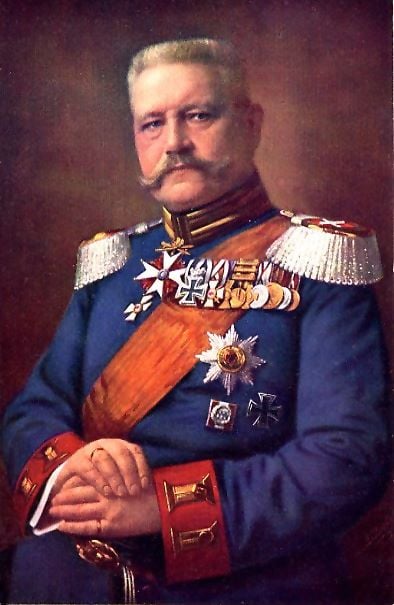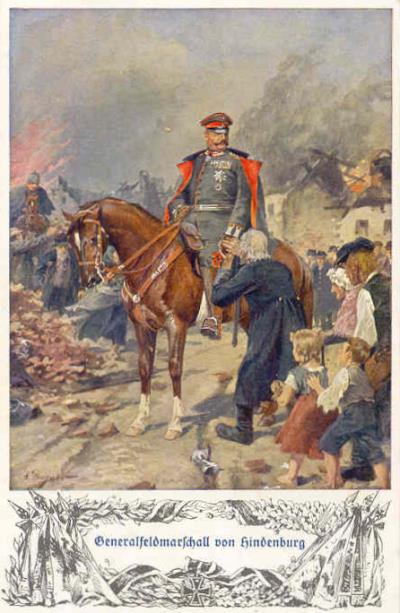HUMMEL: Liberation of East Prussia 1914
August 1914 – east front
The German supreme army command (Oberste Heeresleitung = OHL) was in a precarious position – unlike their expectations the Russian troops already started their push in the mid of August. Urged by France and England, the 1st Russian army (Njemen-army) and the 2nd Russian army (Narew-army) attacked East Prussia before their mobilization was completed.
East Prussia was protected by the German 8th Army and both Russian armies were instructed to surround the German army.
Colonel General Max von Prittwitz, leader of the 8th Army, attacked the Njemen-Army to avert this threat, but in the battle of Gumbinnen on 19./20. August 1914 he met his Waterloo. In order to escape from the menace of encirclement through the approaching Narew-Army, he ordered the fallback behind the river Weichsel, and relinquished East Prussia to both Russian Armies.
The population escaped in panic for fear of assault by the Russians. Prittwitz fallback command was crtiticized enormously in the OHL and led to his separation.
But who was able to save the day then?
A few days earlier, General von Stein, member of the supreme General staff, received a letter from General Paul von Hindenburg, who retired in 1911.
„ ...you can certainly imagine how I feel, seeing my contemporaries pulling away into the battle, while I’m sitting here, can’t do anything. So if there is any requirement for a higher leader, please think of me, I’m ashamed, I can’t walk along the street ...“

Field marshall Hindenburg - contemporary postcard
Finally Hindenburg received his enlistment on Aug.22.1914. He got the supreme command of the 8th Army, General Erich Ludendorff became his chief of staff.
The Germans picked up the Russian radiotraffic and after they capured a written instruction of the Russian army group command, they knew the intentions of their Russian combatant.
Hindenburg jumped at the chance, although the Njemen Army was only a day's march away, the two Russian armies were seperated through the Masurian Lakes. The 150,000 men army was formed up again and despite their inferiority German 8th Army attacked again.
Hindenburg only led a cavalry division back to defend a 60km wide area where the Njemen Army could get through and aimed the push against the Narew-Army near Allenstein.
Between Aug.26. and 31.1914 the 2nd Russian Army under leadership of General Samsonov was encircled. the superiority of the German artillery and the stolidness of the Russian army helped the German 8th Army to win the day. 92,000 prisoners of war and more than 300 cannons were captured in this Victory.
The Russian leader of the Narew Army, General Alexandr Wassiljewitsch Samsonov committed suicide on Aug.30.1914.

Battle of Tannenberg – from a painting of G. Kamelhard
The remaining Njemen Army took a defensive position in northeast of the Masurian lakes after the 2nd Russian Army was defeated.
For the following offensive, the conquering 8th Army was reinforced through 5 infantry and 1 cavalry divisions from the west front.
Since Sep.8.1914 the right wing of the 8th Army advanced southerly of the Russian troops and surrounded their defensive position. In view of the threatening encirclement, the Russian troops decided for a complete fallback, after some short combats. Another 45.000 Russian soldiers came into war captivity.
After the Russian failed their offensive in East Prussia, the two victorious battles were celebrated euphorically as “Victory of Tannenberg.”

Hindenburg is acclaimed by East Prussian people – contemporary postcard
Some medals were made on this occasion.
My example by August Hummel is a proof, unfortunately it has a couple of marks in the fields and it seems to me that it has got some (cabinet?) friction, especially Hindenburgs tip of the nose looks like he has lain on it for a long time. And somebody started to try a cleaning in the reverse fields, where the toning is missing.
But it is still a nice piece of history, or what do you think?
Obverse:
Generalfeldmarschall von Beneckendorff und Hindenburg
Field marshall Hindenburg
Reverse:
Naked man beating the Russian bear
Zur Befreiung Ostpreussens (On the Liberation of East Prussia)

The German supreme army command (Oberste Heeresleitung = OHL) was in a precarious position – unlike their expectations the Russian troops already started their push in the mid of August. Urged by France and England, the 1st Russian army (Njemen-army) and the 2nd Russian army (Narew-army) attacked East Prussia before their mobilization was completed.
East Prussia was protected by the German 8th Army and both Russian armies were instructed to surround the German army.
Colonel General Max von Prittwitz, leader of the 8th Army, attacked the Njemen-Army to avert this threat, but in the battle of Gumbinnen on 19./20. August 1914 he met his Waterloo. In order to escape from the menace of encirclement through the approaching Narew-Army, he ordered the fallback behind the river Weichsel, and relinquished East Prussia to both Russian Armies.
The population escaped in panic for fear of assault by the Russians. Prittwitz fallback command was crtiticized enormously in the OHL and led to his separation.
But who was able to save the day then?
A few days earlier, General von Stein, member of the supreme General staff, received a letter from General Paul von Hindenburg, who retired in 1911.
„ ...you can certainly imagine how I feel, seeing my contemporaries pulling away into the battle, while I’m sitting here, can’t do anything. So if there is any requirement for a higher leader, please think of me, I’m ashamed, I can’t walk along the street ...“

Field marshall Hindenburg - contemporary postcard
Finally Hindenburg received his enlistment on Aug.22.1914. He got the supreme command of the 8th Army, General Erich Ludendorff became his chief of staff.
The Germans picked up the Russian radiotraffic and after they capured a written instruction of the Russian army group command, they knew the intentions of their Russian combatant.
Hindenburg jumped at the chance, although the Njemen Army was only a day's march away, the two Russian armies were seperated through the Masurian Lakes. The 150,000 men army was formed up again and despite their inferiority German 8th Army attacked again.
Hindenburg only led a cavalry division back to defend a 60km wide area where the Njemen Army could get through and aimed the push against the Narew-Army near Allenstein.
Between Aug.26. and 31.1914 the 2nd Russian Army under leadership of General Samsonov was encircled. the superiority of the German artillery and the stolidness of the Russian army helped the German 8th Army to win the day. 92,000 prisoners of war and more than 300 cannons were captured in this Victory.
The Russian leader of the Narew Army, General Alexandr Wassiljewitsch Samsonov committed suicide on Aug.30.1914.

Battle of Tannenberg – from a painting of G. Kamelhard
The remaining Njemen Army took a defensive position in northeast of the Masurian lakes after the 2nd Russian Army was defeated.
For the following offensive, the conquering 8th Army was reinforced through 5 infantry and 1 cavalry divisions from the west front.
Since Sep.8.1914 the right wing of the 8th Army advanced southerly of the Russian troops and surrounded their defensive position. In view of the threatening encirclement, the Russian troops decided for a complete fallback, after some short combats. Another 45.000 Russian soldiers came into war captivity.
After the Russian failed their offensive in East Prussia, the two victorious battles were celebrated euphorically as “Victory of Tannenberg.”

Hindenburg is acclaimed by East Prussian people – contemporary postcard
Some medals were made on this occasion.
My example by August Hummel is a proof, unfortunately it has a couple of marks in the fields and it seems to me that it has got some (cabinet?) friction, especially Hindenburgs tip of the nose looks like he has lain on it for a long time. And somebody started to try a cleaning in the reverse fields, where the toning is missing.
But it is still a nice piece of history, or what do you think?
Obverse:
Generalfeldmarschall von Beneckendorff und Hindenburg
Field marshall Hindenburg
Reverse:
Naked man beating the Russian bear
Zur Befreiung Ostpreussens (On the Liberation of East Prussia)



1
Comments
09/07/2006
Collecting:
Conder tokens
19th & 20th Century coins from Great Britain and the Realm
is that you end up being governed by inferiors. – Plato
Cathy
karlgoetzmedals.com
secessionistmedals.com
<< <i>Excellent medal and history-great post!
My OmniCoin Collection
My BankNoteBank Collection
Tom, formerly in Albuquerque, NM.
BTW, Udo, do you also collect post cards? I know I was always tempted by some of the historic and artistic ones at the fleamarkets and coin/stamp shows in Germany
My wantlist & references
Nominate for: POTD
Great writeup - thank you for taking the time.
<< <i>Awesome!
BTW, Udo, do you also collect post cards? I know I was always tempted by some of the historic and artistic ones at the fleamarkets and coin/stamp shows in Germany
Not seriously, spoon, only when I find some examples that fit to my coins or medals.
Thanks for the nomination, JZ
We need more of these!
"Ask, and it shall be given you; seek, and ye shall find; knock, and it shall be opened unto you." -Luke 11:9
"Hear, O Israel: The LORD our God is one LORD: And thou shalt love the LORD thy God with all thine heart, and with all thy soul, and with all thy might." -Deut. 6:4-5
"For the LORD is our judge, the LORD is our lawgiver, the LORD is our king; He will save us." -Isaiah 33:22
WNC Coins, LLC
1987-C Hendersonville Road
Asheville, NC 28803
wnccoins.com
Experience the World through Numismatics...it's more than you can imagine.
Many thanks to all
Still looking for past winners…
Experience the World through Numismatics...it's more than you can imagine.